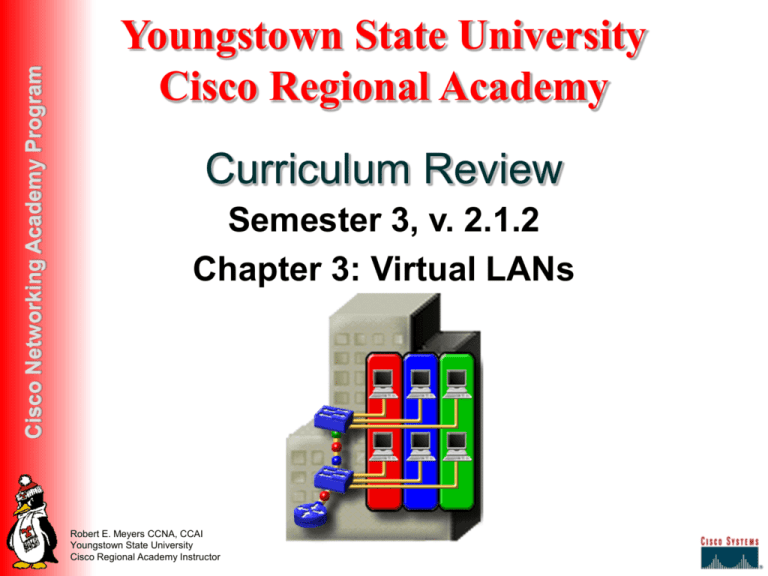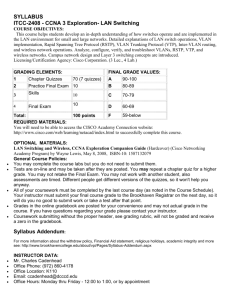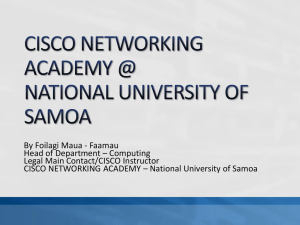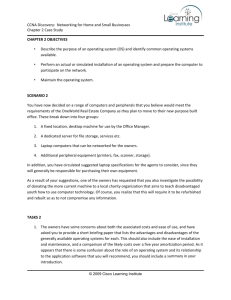Sem3v212ch3revu - YSU Computer Science & Information
advertisement

Cisco Networking Academy Program Youngstown State University Cisco Regional Academy Curriculum Review Semester 3, v. 2.1.2 Chapter 3: Virtual LANs Robert E. Meyers CCNA, CCAI Youngstown State University Cisco Regional Academy Instructor Cisco Networking Academy Program Disclaimer This presentation is intended for review purposes by Cisco Networking Academy Program teachers and students only. This presentation is not a substitute for careful study of the Cisco Academy curriculum. Most of the text and graphics have been copied directly from the on-line curriculum, and remain the copyrighted property of Cisco Systems. CCNA 640-507 objectives are used for all YSU Regional authored reviews. Robert E. Meyers CCNA, CCAI Youngstown State University Cisco Regional Academy Instructor Cisco Networking Academy Program Contents Part 1: VLANs Part 2: Segmenting with Switches Part 3: VLAN Implementation Part 4:Benefits of VLANs Robert E. Meyers CCNA, CCAI Youngstown State University Cisco Regional Academy Instructor Cisco Networking Academy Program Chapter Learning Objectives You will be able to: – Define the role of a switch in creating VLANs. – Describe frame filtering and frame tagging. – Describe beneficial reasons for implementing VLANs. – Explain port centric, static, and dynamic VLANs. – Explain how VLANs control broadcasts. Robert E. Meyers CCNA, CCAI Youngstown State University Cisco Regional Academy Instructor Cisco Networking Academy Program Part 1 Virtual LANs Robert E. Meyers CCNA, CCAI Youngstown State University Cisco Regional Academy Instructor Cisco Networking Academy Program VLAN: Overview Traditional LANs are: – Configured according to Layer 1 requirements. – Grouped by their location relative to the hub and cable runs to the IDF/MDF. – Not segmented by workgroup association or need for bandwidth. – The “structure” is controlled by the physical layout, not the logical needs. Robert E. Meyers CCNA, CCAI Youngstown State University Cisco Regional Academy Instructor Cisco Networking Academy Program VLANs: Overview A VLAN is a logical grouping of devices or users that can be grouped by: – function, – department, – or application, Regardless of their physical segment location. Logical requirements rule over the physical layout. Robert E. Meyers CCNA, CCAI Youngstown State University Cisco Regional Academy Instructor Cisco Networking Academy Program VLANs: Overview A group of ports or users in the same broadcast domain. Can be selected according to: – – – – Port ID number MAC address Protocol Application Use switches and proprietary software. Robert E. Meyers CCNA, CCAI Youngstown State University Cisco Regional Academy Instructor Cisco Networking Academy Program Part 2 Segmenting with Switches Robert E. Meyers CCNA, CCAI Youngstown State University Cisco Regional Academy Instructor Cisco Networking Academy Program Removing the Physical Boundary Using VLANs, you can group switch ports and their users into logically defined workgroups, such as: – Coworkers in the same department. – A cross-functional product team. – User groups sharing the same application. Single or multiple switches can be used. Robert E. Meyers CCNA, CCAI Youngstown State University Cisco Regional Academy Instructor Cisco Networking Academy Program VLAN’s Across the Backbone To eliminate the physical restriction: – VLAN information between interconnected switches and routers, must be carried and reside on the corporate backbone. Robert E. Meyers CCNA, CCAI Youngstown State University Cisco Regional Academy Instructor Cisco Networking Academy Program Routers in the VLAN Still provide: – Broadcast control – Route processing – Subnet connectivity But now also: – Connect the VLANs that are “logically” created but are not on the same “physical” location! Robert E. Meyers CCNA, CCAI Youngstown State University Cisco Regional Academy Instructor Cisco Networking Academy Program VLAN Frames Switches make filtering and forwarding decisions by frame, using VLAN metrics. – Frame filtering – Frame tagging A frame is compared to the metrics and then is: – sent, – filtered, – or broadcast. Robert E. Meyers CCNA, CCAI Youngstown State University Cisco Regional Academy Instructor Cisco Networking Academy Program Frame Filtering Each switch develops a filtering table. Each frame can be filtered according to: – MAC address, or – Layer 3 protocol type • IP • IPX, etc. Like routers, switches share address table data across the backbone. Robert E. Meyers CCNA, CCAI Youngstown State University Cisco Regional Academy Instructor Cisco Networking Academy Program Frame Tagging Places a unique ID in the header of each frame as it is moves through the network backbone. – ID is understood and examined by each switch prior to any broadcasts or transmissions to other switches, routers, or hosts. – Functions at Layer 2; low administration! – Selected by IEEE as VLAN standard. • IEEE 802.1q Robert E. Meyers CCNA, CCAI Youngstown State University Cisco Regional Academy Instructor Cisco Networking Academy Program Part 3 VLAN Implementation Robert E. Meyers CCNA, CCAI Youngstown State University Cisco Regional Academy Instructor Cisco Networking Academy Program VLAN Ports and Broadcasts Each switch port can be assigned to a VLAN. – Only ports assigned to the same VLAN share broadcasts. – Switched VLANs can therefore segment broadcast domains like routers. Robert E. Meyers CCNA, CCAI Youngstown State University Cisco Regional Academy Instructor Cisco Networking Academy Program Types of VLANs Three types of VLAN implementation – Port-centric – Static – Dynamic Robert E. Meyers CCNA, CCAI Youngstown State University Cisco Regional Academy Instructor Cisco Networking Academy Program Port Centric All nodes connected to ports in the same VLAN are assigned the same VLAN ID. – Users are assigned by port. – Easy administration. – Increased security between VLANs. – Packets do not "leak" into other domains. Robert E. Meyers CCNA, CCAI Youngstown State University Cisco Regional Academy Instructor Cisco Networking Academy Program Static VLANs Switch ports are assigned to a VLAN. – Any host that plugs into a port is automatically a member of that port’s VLAN gorup. Easy to configure and monitor. Robert E. Meyers CCNA, CCAI Youngstown State University Cisco Regional Academy Instructor Cisco Networking Academy Program Dynamic VLAN’s Central database server maintains the VLAN assignments. – When a new host is connected to an open port, the switch checks the database for VLAN assignment. – Assignment based on: • MAC • Logical address • Protocol type. Robert E. Meyers CCNA, CCAI Youngstown State University Cisco Regional Academy Instructor Cisco Networking Academy Program Part 4 Benefits of VLANs Robert E. Meyers CCNA, CCAI Youngstown State University Cisco Regional Academy Instructor Cisco Networking Academy Program Moving Hosts Physical moves are one of network managers biggest headache. – Moves and additions require the least amount of reconfiguration when using VLANs. – Hosts can move without changing IP or subnet membership as long as: • They are connected to a VLAN switch. • Retain their VLAN ID. Robert E. Meyers CCNA, CCAI Youngstown State University Cisco Regional Academy Instructor Cisco Networking Academy Program VLANs Control Broadcasts Switches not using VLANs, send broadcasts out every port just like a hub. Broadcast traffic within one VLAN is not sent outside that VLAN. – The smaller the VLAN membership, the less hosts have to deal with excess broadcast traffic. Robert E. Meyers CCNA, CCAI Youngstown State University Cisco Regional Academy Instructor Cisco Networking Academy Program Improved Security A network manager can: – Restrict the number of users in a VLAN group – Prevent a user from joining the VLAN without first receiving approval. Used with router ACL’s for tight control. Robert E. Meyers CCNA, CCAI Youngstown State University Cisco Regional Academy Instructor Cisco Networking Academy Program Save Money! Use existing hubs to connect many VLAN members to the same VLAN switch port. Relocating a host to a new VLAN can be as easy as plugging into a different hub. Robert E. Meyers CCNA, CCAI Youngstown State University Cisco Regional Academy Instructor Cisco Networking Academy Program Summary Switched VLANs are a secure, layer 2, cost effective way to group users regardless of physical location. VLAN membership ID can travel the backbone. Common ID groupings are filtering, frame tagging, and frame identification. VLAN’s provide – Broadcast Control – Workgroup security – Cost effective additions or moving of hosts. Robert E. Meyers CCNA, CCAI Youngstown State University Cisco Regional Academy Instructor Cisco Networking Academy Program End Robert E. Meyers CCNA, CCAI Youngstown State University Cisco Regional Academy Instructor






